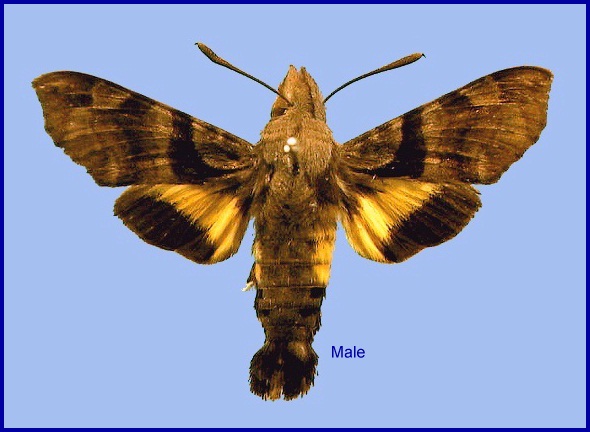
Macroglossa nycteris Kollar, 1844, in Kollar & Redtenbacher, in Hügel, Kaschmir und das Reich der Siek 4(2): 458. Type locality: [India, Uttarakhand,] Massuri [Mussoorie].
Synonym. Macroglossa volucris Walker, 1856.
Synonym. Rhopalopsyche nycteris (Butler, 1875).
Wingspan: 40--48mm. Head, thorax and abdomen greyish-brown, abdomen with maize-yellow side-patches on the first three segments; the penultimate segment fringed with white; four lateral tufts increasing in size posteriorly, the first two white, the others black tipped with orange, anal tufts black. Forewing greyish-brown; some subbasal indistinct lines, an antemedian band recurved towards base at inner margin; three postmedian curved lines; a square brown spot on costa before apex with a black spot below it from which a waved, oblique line runs to apex. Hindwing blackish-brown with a broad, median, maize-yellow band (Bell & Scott, 1937).
In the male genitalia, uncus slender, pointed. Gnathos rounded apically. Valve without stridulatory scales. Harpe slender, pointed, somewhat longitudinally grooved dorsally. Phallus with a very long, pointed process, curving at least halfway round the phallus; the base of the process projecting, with few teeth; the proximal and distal edges of the process denticulate; internal rods obtuse apically, the longer one clubbed, denticulate on one edge.

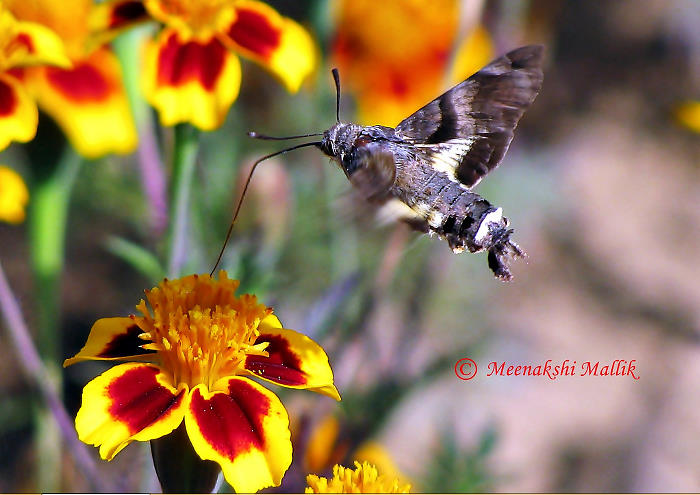
Like with most Macroglossum, a diurnal species. Emerges from the pupa in the early morning and takes flight a few hours later.
China: iii (Yunnan); v (Hubei; Shandong; Yunnan); vii (Beijing; Shaanxi; Shanghai; Sichuan; Zhejiang); viii (Yunnan); 19.x (Beijing); 21.x (Henan); xi (S Gansu).
OVUM: Bright green, nearly spherical, shiny and smooth (Bell & Scott, 1937).
LARVA: Full-fed 40mm, width 7mm, horn 6mm. According to Bell & Scott (1937), in the first instar head round, body short and cylindrical, horn very short, nearly cylindrical, a long bristle on each point of the bifid tip. Head and segments 2, 3 and 14 covered with bristle-like hairs; median segments with four lines of similar hairs on each side of the dorsal line þ one subdorsal, one dorso-lateral, one supra- and one subspiracular. Colour greyish-green, the hairs and dots from which they rise black; horn black. In the second instar, head, body and horn covered thickly with short hairs, finer than those of the first instar. Head and body green, with a whitish dorso-lateral stripe from segment 2 to base of horn; horn and hairs black. In the third instar, horn of medium length; hairs short except on head, horn and anal segments. Head and segments 2 and 3 apple-green, rest of body dark bluish-green dotted with white; dorso-lateral stripe bluish; horn dark purple, paler at base. The fourth instar is similar to the third instar, with body still covered with very fine hairs; stripe yellow on segments 2 to 7.
In the fifth and final instar, head round; true clypeus with apex acute, less than half length of head; false clypeus vestigial; labrum one-third length of clypeus and one-quarter as broad as clypeus; ligula kidney-shaped, as long as labrum and as broad as clypeus; cutting-edge of mandible not toothed. Surface of head dull, set sparsely with minute, shiny tubercles. Body dull, Macroglossine in shape. Horn of medium length, tip conical; segment 2 with a broad saddle-shaped marking covered with small tubercles. There is a row of minute tubercles encircling each secondary ring, one tubercle of each row, on the dorso-lateral stripe, larger than the rest, these larger tubercles most prominent on segments 3 and 4, hardly noticeable on the other segments. Horn covered with large, conical tubercles directed distad; anal flap and clasper faces covered with small tubercles (Bell & Scott, 1937).
In the green form, head green with a pale stripe separating face from cheek; labrum and ligula green; basal segments of antenna green, end-segment rusty; mandible green, tip narrowly dark reddish-brown. Body green, the tubercles white. There is a dark green dorsal stripe from segment 2 to base of horn, bordered on each side by paler green. The dorso-lateral stripe is yellow on the anterior segments, white to base of horn; subspiracular region tinged with yellow. Horn purple, tip yellow, tubercles black; legs reddish; prolegs reddish with a black band on the shank; anal flap edged with yellow. Spiracles oval, flush with a narrow rim, reddish in colour.
In the dark-coloured form, head pale brown with a darker stripe separating face from cheek; body-colour dark purple with markings as in the green form (Bell & Scott, 1937).
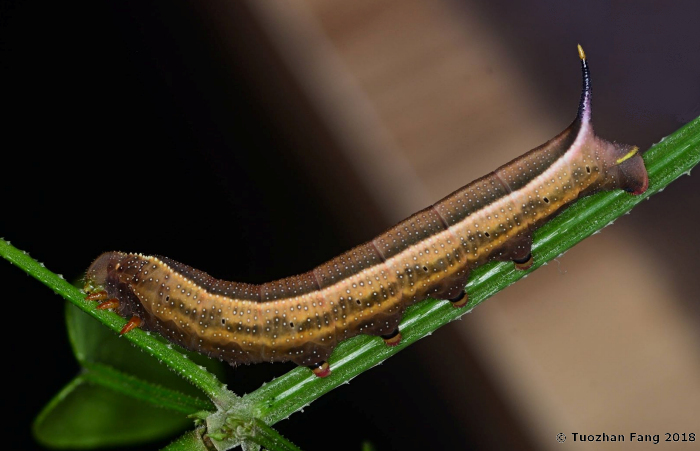
PUPA: 29mm, width 7mm, cremaster 1.5mm. Colour ochreous; frons black; tongue-case suffused with brown; tongue black. With a narrow brown dorsal stripe on thorax. Tibiae of both legs brown; wing-case suffused with brown; inner margin of wing black. Hind margins of abdominal segments 5 to 7 narrowly black; hind bevels of 8 to 10 broadly brown; spiracles black lying on small black patches; cremaster black (Bell & Scott, 1937).
Macroglossine in shape, but abdomen less flattened dorsally. Tongue-case fairly prominent; antenna slightly longer than fore leg; no coxal piece. Surface moderately shiny; head and wing-case smooth; thorax minutely shagreened. Abdomen more coarsely shagreened and pitted laterally towards hind margins of segments; front bevel of segment 9 with a wide deep channel at its front margin, and the rest of bevel covered with narrow, short ridges. Spiracle of 2 indicated by a narrow oval depression almost covered by a small transverse oblong lobe projecting from the front margin of 3; other spiracles oval, flush, edges of central slit raised. Cremaster elongate-triangular, ending in a simple point, flattened dorsally and ventrally, surface shiny, dorsum finely rugose, venter finely longitudinally striate, tip smooth (Bell & Scott, 1937).



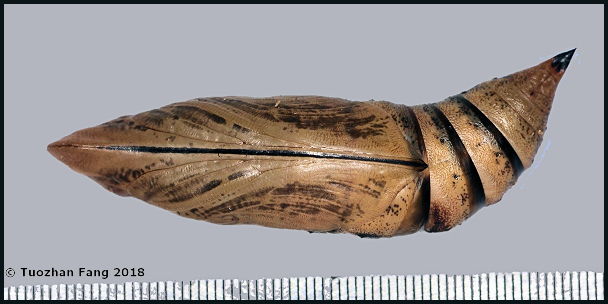
Larval hostplants. So far, only known from Rubia cordifolia (Tuozhan Fang, pers. comm. 2018) and Leptodermis oblonga (YuChen Zhang, pers. comm 2023) in northeastern China, but recorded on Galium and Rubia cordifolia in the Himalaya (Bell & Scott, 1937).
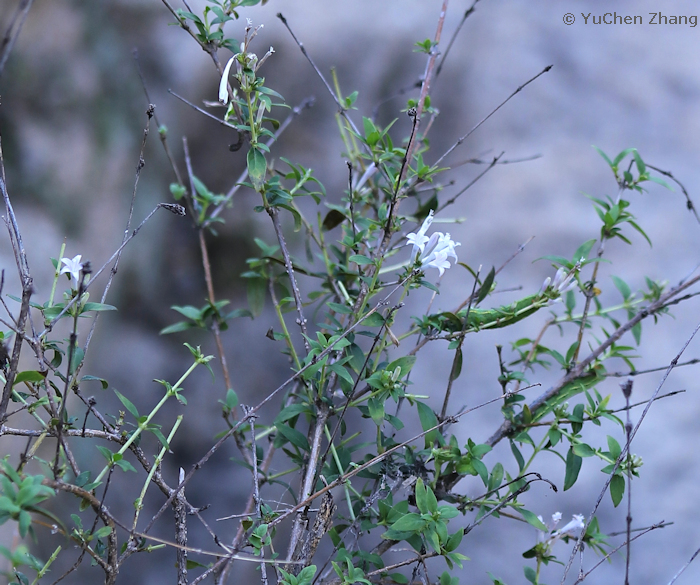
Unknown.
China: Beijing (Changyang; Shentangyu Natural Scenic Area, Huairou County); Shandong (Tai'an; Qingdao); Shaanxi (Taibai Shan); south Gansu (Beishui Hu); Henan; Shanghai (Jiading, 1000'); Zhejiang (Jiakou, 1700'); Hubei (Yichang); Sichuan (Baoxing; Emei Shan; Kangding; Yu Shan; Zhaotong); Chongqing (Fengjie; Jiudi Tanyuan); Yunnan (Kunming; Wenshan; Weixi; Zhaotong; Gaoligong Shan; Mengla, Xishuangbanna; Dali); Guizhou; Hunan (Dayong); Jiangxi (Tiancun).
Japan: Kyushu; Ryukyu Archipelago.
(There are 5 specimens in the NHMUK labelled "Loo Choo Is.", the old name for the Ryukyu Islands; all have the same data. This may be a labelling error as this temperate zone species has never been found in Korea, central and northern Japan, nor Taiwan. Even in eastern China it is a rarity, and confined to the north.)
Occurs from Kamdesch, Nuristan Province, eastern Afghanistan (Wiltshire, 1961) and Pakistan (Rafi et al., 2014; Haxaire, Gujjar & Saeed, 2017) east around the southern margin of the Himalaya (Pathania, Sunita Sharma & Gill, 2014) to northern Burma/Myanmar, then northeast through China as far as Beijing (YuChen Zhang, pers. comm 2023) and Shandong. Absent from tropical southeast Asia, including lowland southeastern China.
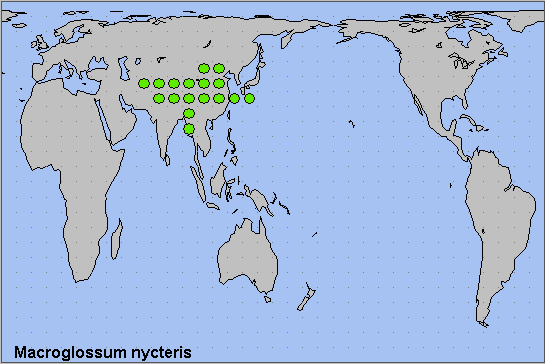
Holarctic; eastern Palaearctic region. Pleistocene refuge: Polycentric.
 Return to Sphingidae of the Eastern Palaearctic species list
Return to Sphingidae of the Eastern Palaearctic species list